Stewart J. Calculus
Подождите немного. Документ загружается.

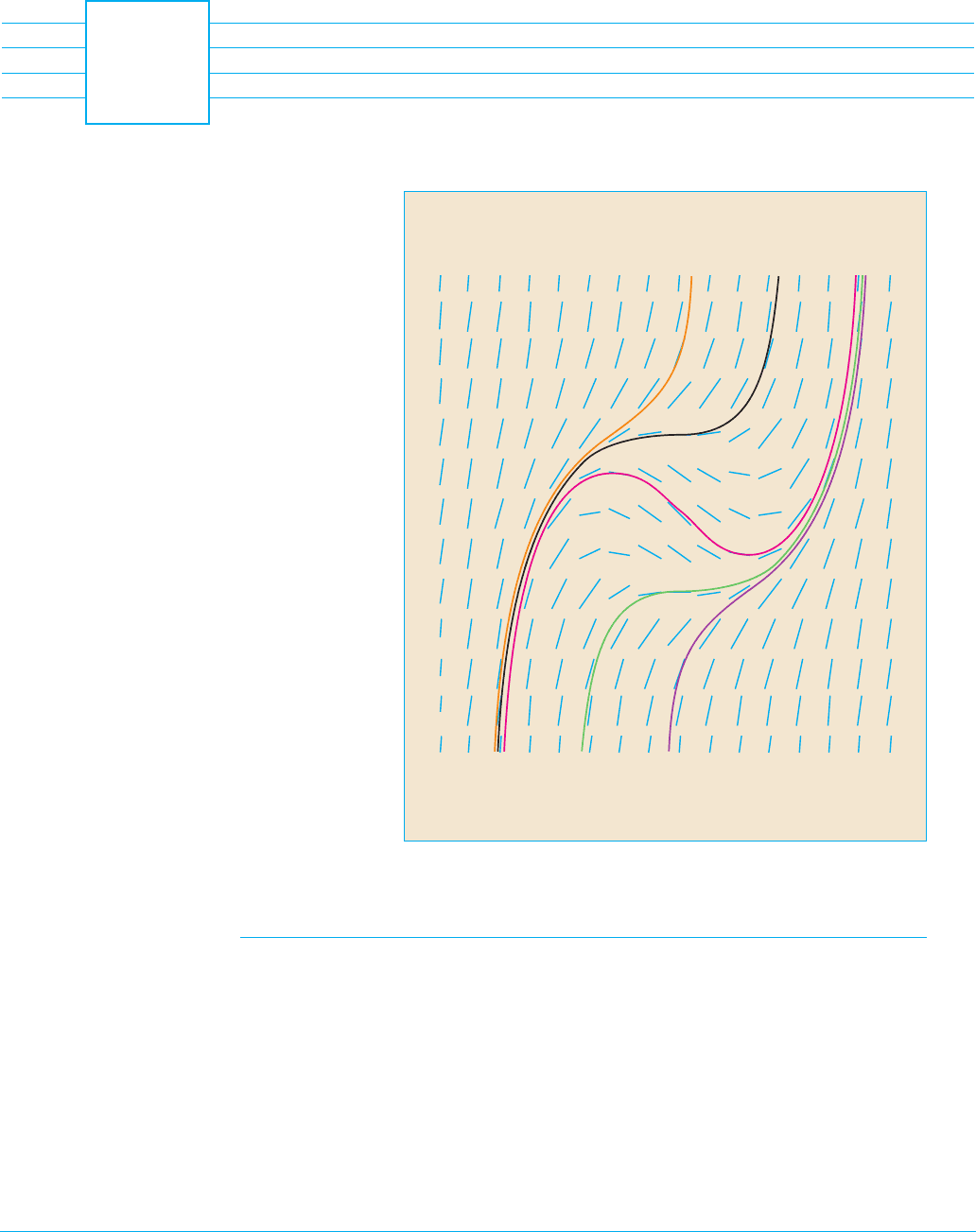
602
Perhaps the most important of all the applications of calculus is to differential equa-
tions. When physical scientists or social scientists use calculus, more often than not
it is to analyze a differential equation that has arisen in the process of modeling some
phenomenon that they are studying. Although it is often impossible to find an explicit
formula for the solution of a differential equation, we will see that graphical and numer-
ical approaches provide the needed information.
Direction fields enable us
to sketch solutions of
differential equations with-
out an explicit formula.
DIFFERENTIAL
EQUATIONS
10

MODELING WITH DIFFERENTIAL EQUATIONS
In describing the process of modeling in Section 1.2, we talked about formulating a math-
ematical model of a real-world problem either through intuitive reasoning about the phe-
nomenon or from a physical law based on evidence from experiments. The mathematical
model often takes the form of a differential equation, that is, an equation that contains an
unknown function and some of its derivatives. This is not surprising because in a real-
world problem we often notice that changes occur and we want to predict future behavior
on the basis of how current values change. Let’s begin by examining several examples of
how differential equations arise when we model physical phenomena.
MODELS OF POPULATION GROWTH
One model for the growth of a population is based on the assumption that the population
grows at a rate proportional to the size of the population. That is a reasonable assumption
for a population of bacteria or animals under ideal conditions (unlimited environment, ade-
quate nutrition, absence of predators, immunity from disease).
Let’s identify and name the variables in this model:
The rate of growth of the population is the derivative . So our assumption that the
rate of growth of the population is proportional to the population size is written as the
equation
where is the proportionality constant. Equation 1 is our first model for population
growth; it is a differential equation because it contains an unknown function P and its
derivative .
Having formulated a model, let’s look at its consequences. If we rule out a population
of 0, then for all t. So, if , then Equation 1 shows that for all t.
This means that the population is always increasing. In fact, as increases, Equation 1
shows that becomes larger. In other words, the growth rate increases as the popula-
tion increases.
Equation 1 asks us to find a function whose derivative is a constant multiple of itself.
We know from Chapter 3 that exponential functions have that property. In fact, if we let
, then
Thus any exponential function of the form is a solution of Equation 1. In Sec-
tion 10.4 we will see that there is no other solution.
Allowing C to vary through all the real numbers, we get the family of solutions
whose graphs are shown in Figure 1. But populations have only positive
values and so we are interested only in the solutions with . And we are probably con-C ! 0
P!t" ! Ce
kt
P!t" ! Ce
kt
P"!t" ! C!ke
kt
" ! k!Ce
kt
" ! kP!t"
P!t" ! Ce
kt
dP#dt
P!t"
P"!t" ! 0k ! 0P!t" ! 0
dP#dt
k
dP
dt
! kP
1
dP#dt
P ! the number of individuals in the population !the dependent variable"
t ! time !the independent variable"
10.1
603
N Now is a good time to read (or reread) the dis-
cussion of mathematical modeling on page 24.
t
P
F I G U R E 1
The family of solutions of dP/dt=kP
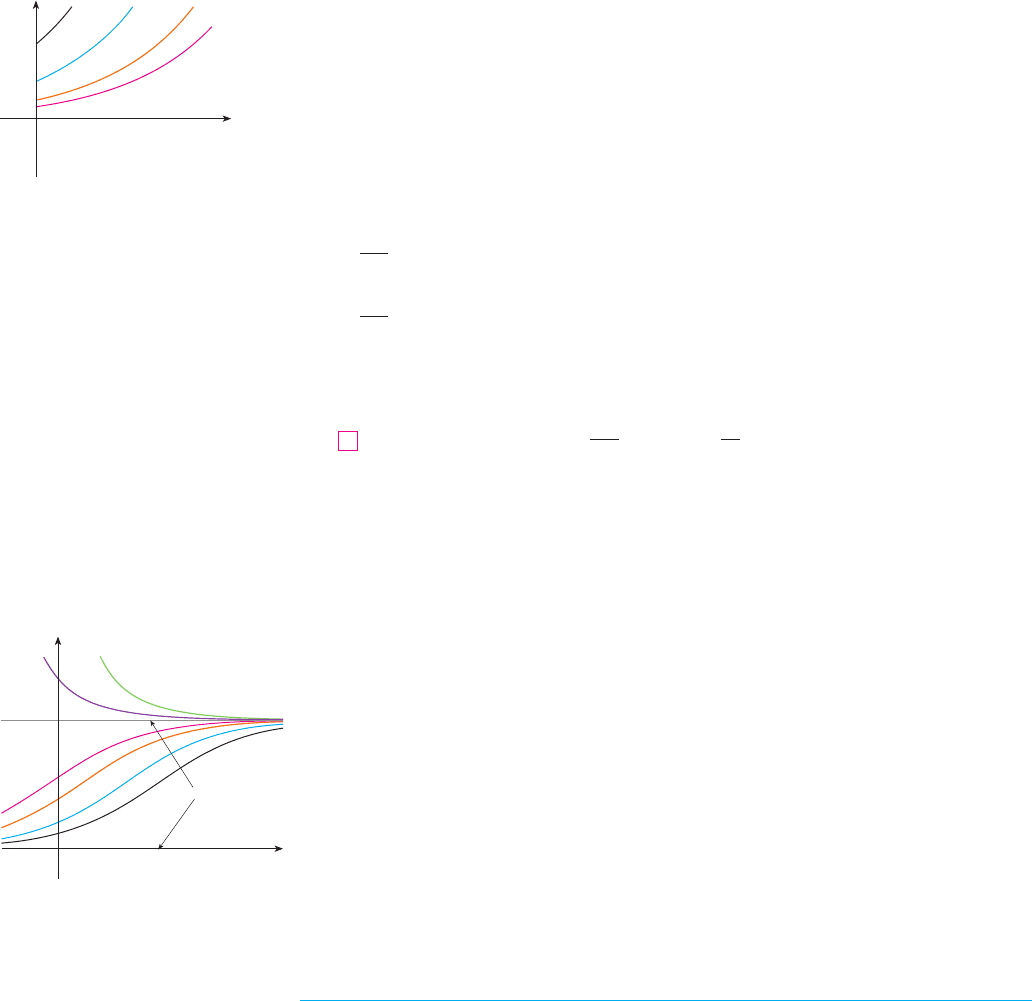
cerned only with values of t greater than the initial time . Figure 2 shows the physi-
cally meaningful solutions. Putting , we get , so the constant C
turns out to be the initial population, .
Equation 1 is appropriate for modeling population growth under ideal conditions, but
we have to recognize that a more realistic model must reflect the fact that a given environ-
ment has limited resources. Many populations start by increasing in an exponential man-
ner, but the population levels off when it approaches its carrying capacity K (or decreases
toward K if it ever exceeds K). For a model to take into account both trends, we make two
assumptions:
N
if P is small (Initially, the growth rate is proportional to P.)
N
if (P decreases if it ever exceeds K.)
A simple expression that incorporates both assumptions is given by the equation
Notice that if P is small compared with K, then is close to 0 and so . If
, then is negative and so .
Equation 2 is called the logistic differential equation and was proposed by the Dutch
mathematical biologist Pierre-François Verhulst in the 1840s as a model for world popula-
tion growth. We will develop techniques that enable us to find explicit solutions of the
logistic equation in Section 10.4, but for now we can deduce qualitative characteristics of
the solutions directly from Equation 2. We first observe that the constant functions
and are solutions because, in either case, one of the factors on the right
side of Equation 2 is zero. (This certainly makes physical sense: If the population is ever
either 0 or at the carrying capacity, it stays that way.) These two constant solutions are
called equilibrium solutions.
If the initial population lies between 0 and K, then the right side of Equation 2 is
positive, so and the population increases. But if the population exceeds the car-
rying capacity , then is negative, so and the population
decreases. Notice that, in either case, if the population approaches the carrying capacity
, then , which means the population levels off. So we expect that the
solutions of the logistic differential equation have graphs that look something like the ones
in Figure 3. Notice that the graphs move away from the equilibrium solution and
move toward the equilibrium solution .
A MODEL FOR THE MOTION OF A SPRING
Let’s now look at an example of a model from the physical sciences. We consider the
motion of an object with mass m at the end of a vertical spring (as in Figure 4). In Sec-
tion 6.4 we discussed Hooke’s Law, which says that if the spring is stretched (or com-
pressed) x units from its natural length, then it exerts a force that is proportional to x:
where k is a positive constant (called the spring constant). If we ignore any external resist-
ing forces (due to air resistance or friction) then, by Newton’s Second Law (force equals
restoring force ! #kx
P ! K
P ! 0
dP#dt l 0!P l K"
dP#dt
$
01 # P#K!P ! K"
dP#dt ! 0
P!0"
P!t" ! KP!t" ! 0
dP#dt
$
01 # P#KP ! K
dP#dt $ kPP#K
dP
dt
! kP
%
1 #
P
K
&
2
P ! K
dP
dt
$
0
dP
dt
$ kP
P!0"
P!0" ! Ce
k!0"
! Ct ! 0
t ! 0
604
|| ||
CHAPTER 10 DIFFERENTIAL EQUATIONS
0 t
P
F I G U R E 2
The family of solutions P(t)=Ce
kt
with C>0 and t˘0
F I G U R E 3
Solutions of the logistic equation
t
P
0
P=K
P =0
equilibrium
solutions
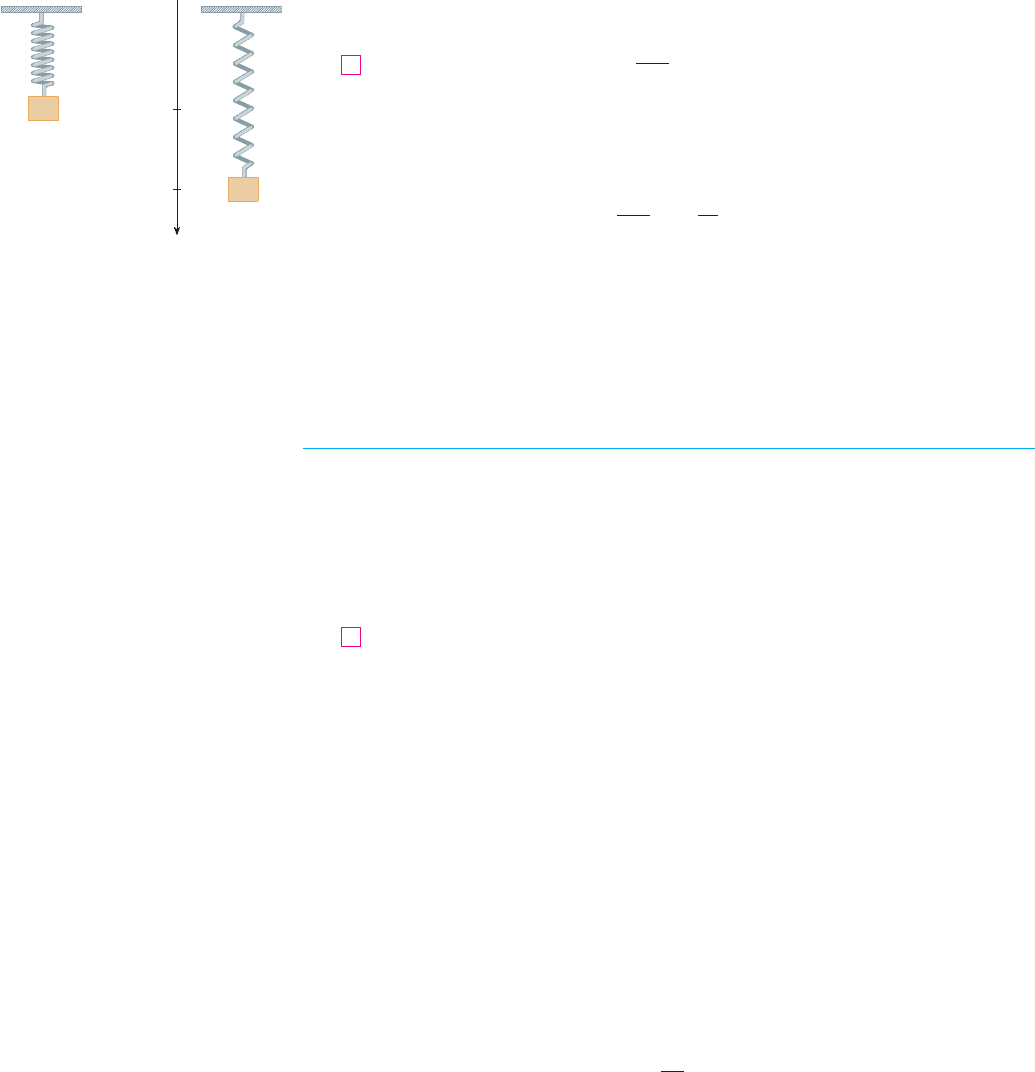
mass times acceleration), we have
This is an example of what is called a second-order differential equation because it
involves second derivatives. Let’s see what we can guess about the form of the solution
directly from the equation. We can rewrite Equation 3 in the form
which says that the second derivative of x is proportional to x but has the opposite sign. We
know two functions with this property, the sine and cosine functions. In fact, it turns
out that all solutions of Equation 3 can be written as combinations of certain sine
and cosine functions (see Exercise 4). This is not surprising; we expect the spring to oscil-
late about its equilibrium position and so it is natural to think that trigonometric functions
are involved.
GENERAL DIFFERENTIAL EQUATIONS
In general, a differential equation is an equation that contains an unknown function and
one or more of its derivatives. The order of a differential equation is the order of the high-
est derivative that occurs in the equation. Thus Equations 1 and 2 are first-order equations
and Equation 3 is a second-order equation. In all three of those equations the independent
variable is called t and represents time, but in general the independent variable doesn’t
have to represent time. For example, when we consider the differential equation
it is understood that y is an unknown function of x.
A function is called a solution of a differential equation if the equation is satisfied
when and its derivatives are substituted into the equation. Thus is a solution of
Equation 4 if
for all values of x in some interval.
When we are asked to solve a differential equation we are expected to find all possible
solutions of the equation. We have already solved some particularly simple differential
equations, namely, those of the form
For instance, we know that the general solution of the differential equation
is given by
where C is an arbitrary constant.
But, in general, solving a differential equation is not an easy matter. There is no sys-
tematic technique that enables us to solve all differential equations. In Section 10.2, how-
ever, we will see how to draw rough graphs of solutions even when we have no explicit
formula. We will also learn how to find numerical approximations to solutions.
y !
x
4
4
% C
y" ! x
3
y" ! f !x"
f "!x" ! x f !x"
fy ! f !x"
f
y" ! xy
4
d
2
x
dt
2
! #
k
m
x
m
d
2
x
dt
2
! #kx
3
SECTION 10.1 MODELING WITH DIFFERENTIAL EQUATIONS
|| ||
605
F I G U R E 4
m
x
0
x
m
equilibrium
position

EXAMPLE 1 Show that every member of the family of functions
is a solution of the differential equation .
SOLUTION We use the Quotient Rule to differentiate the expression for y:
The right side of the differential equation becomes
Therefore, for every value of c, the given function is a solution of the differential
equation.
M
When applying differential equations, we are usually not as interested in finding a fam-
ily of solutions (the general solution) as we are in finding a solution that satisfies some
additional requirement. In many physical problems we need to find the particular solution
that satisfies a condition of the form . This is called an initial condition, and the
problem of finding a solution of the differential equation that satisfies the initial condition
is called an initial-value problem.
Geometrically, when we impose an initial condition, we look at the family of solution
curves and pick the one that passes through the point . Physically, this corresponds
to measuring the state of a system at time and using the solution of the initial-value prob-
lem to predict the future behavior of the system.
EXAMPLE 2 Find a solution of the differential equation that satisfies
the initial condition .
SOLUTION Substituting the values and into the formula
from Example 1, we get
Solving this equation for c, we get , which gives . So the solution
of the initial-value problem is
M
y !
1 %
1
3
e
t
1 #
1
3
e
t
!
3 % e
t
3 # e
t
c !
1
3
2 # 2c ! 1 % c
2 !
1 % ce
0
1 # ce
0
!
1 % c
1 # c
y !
1 % ce
t
1 # ce
t
y ! 2t ! 0
y!0" ! 2
y" !
1
2
!y
2
# 1"
V
t
0
!t
0
, y
0
"
y!t
0
" ! y
0
!
1
2
4ce
t
!1 # ce
t
"
2
!
2ce
t
!1 # ce
t
"
2
1
2
!y
2
# 1" !
1
2
'%
1 % ce
t
1 # ce
t
&
2
# 1
(
!
1
2
'
!1 % ce
t
"
2
# !1 # ce
t
"
2
!1 # ce
t
"
2
(
!
ce
t
# c
2
e
2t
% ce
t
% c
2
e
2t
!1 # ce
t
"
2
!
2ce
t
!1 # ce
t
"
2
y" !
!1 # ce
t
"!ce
t
" # !1 % ce
t
"!#ce
t
"
!1 # ce
t
"
2
y" !
1
2
!y
2
# 1"
y !
1 % ce
t
1 # ce
t
V
606
|| ||
CHAPTER 10 DIFFERENTIAL EQUATIONS
N Figure 5 shows graphs of seven members of
the family in Example 1. The differential equation
shows that if , then . That is
borne out by the flatness of the graphs near
and .y ! #1y ! 1
y" $ 0y $ &1
5
_5
_5 5
F I G U R E 5
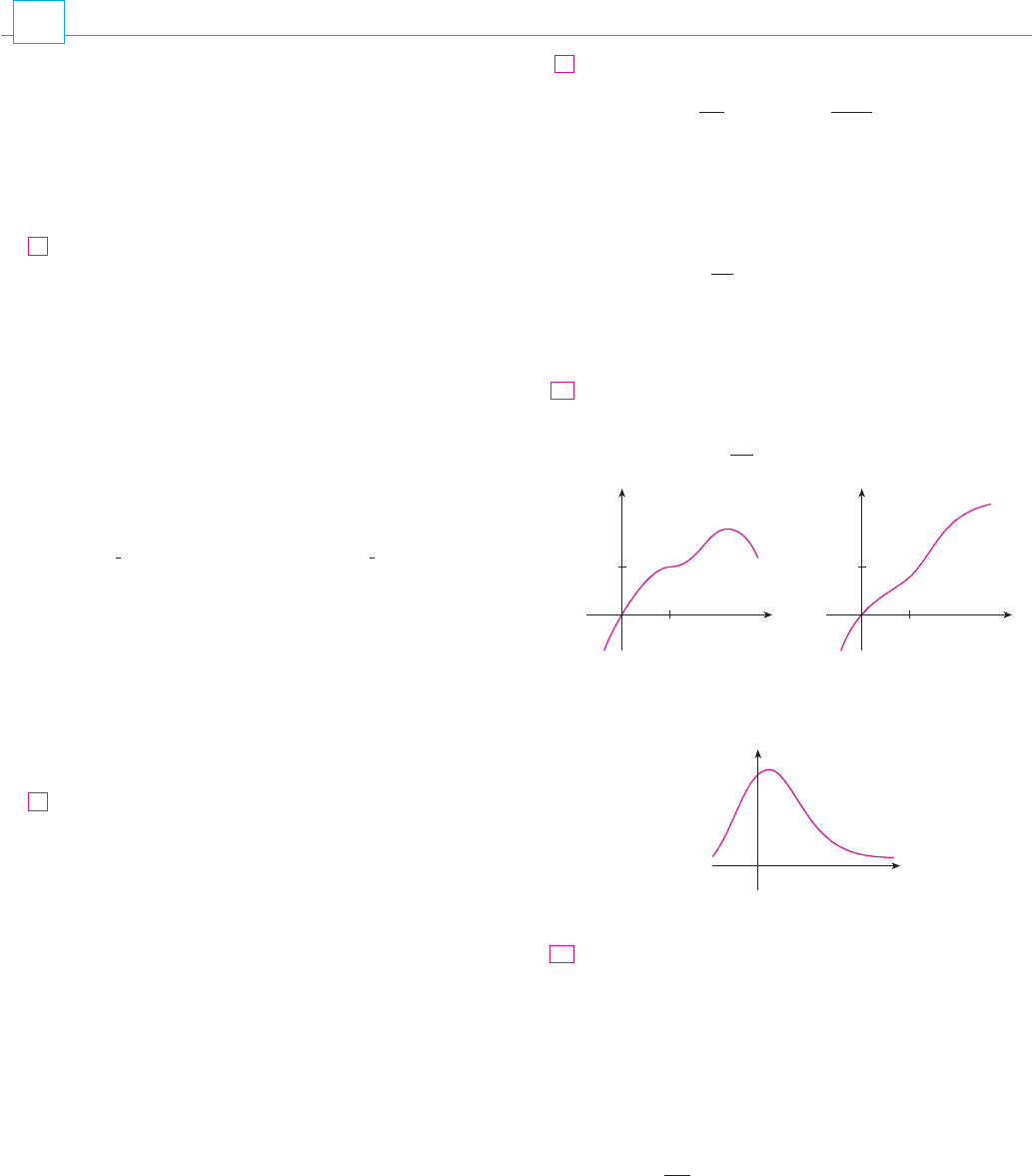
SECTION 10.1 MODELING WITH DIFFERENTIAL EQUATIONS
|| ||
607
A population is modeled by the differential equation
(a) For what values of is the population increasing?
(b) For what values of is the population decreasing?
(c) What are the equilibrium solutions?
10. A function satisfies the differential equation
(a) What are the constant solutions of the equation?
(b) For what values of is increasing?
(c) For what values of is decreasing?
Explain why the functions with the given graphs can’t be
solutions of the differential equation
12. The function with the given graph is a solution of one of the
following differential equations. Decide which is the correct
equation and justify your answer.
A. B. C.
Psychologists interested in learning theory study learning
curves. A learning curve is the graph of a function , the
performance of someone learning a skill as a function of the
training time . The derivative represents the rate at
which performance improves.
(a) When do you think increases most rapidly? What hap-
pens to as increases? Explain.
(b) If is the maximum level of performance of which the
learner is capable, explain why the differential equation
is a reasonable model for learning.
k a positive constant
dP
dt
! k!M # P"
M
tdP#dt
P
dP#dtt
P!t"
13.
y" ! 1 # 2xyy" ! #2xyy" ! 1 % xy
0 x
y
y
t
1
1
y
t
1
1
(a) (b)
dy
dt
! e
t
!y # 1"
2
11.
yy
yy
dy
dt
! y
4
# 6y
3
% 5y
2
y!t"
P
P
dP
dt
! 1.2P
%
1 #
P
4200
&
9.
1. Show that is a solution of the differential equa-
tion .
2. Verify that is a solution of the
initial-value problem
on the interval .
(a) For what values of does the function satisfy the
differential equation ?
(b) If and are the values of that you found in part (a),
show that every member of the family of functions
is also a solution.
4. (a) For what values of does the function satisfy
the differential equation ?
(b) For those values of , verify that every member of the
family of functions is also a
solution.
5. Which of the following functions are solutions of the differ-
ential equation ?
(a) (b)
(c) (d)
6. (a) Show that every member of the family of functions
is a solution of the differential equation
.
;
(b) Illustrate part (a) by graphing several members of the
family of solutions on a common screen.
(c) Find a solution of the differential equation that satisfies
the initial condition .
(d) Find a solution of the differential equation that satisfies
the initial condition .
(a) What can you say about a solution of the equation
just by looking at the differential equation?
(b) Verify that all members of the family are
solutions of the equation in part (a).
(c) Can you think of a solution of the differential equation
that is not a member of the family in part (b)?
(d) Find a solution of the initial-value problem
8. (a) What can you say about the graph of a solution of the
equation when is close to 0? What if is
large?
(b) Verify that all members of the family are
solutions of the differential equation .
;
(c) Graph several members of the family of solutions on a
common screen. Do the graphs confirm what you pre-
dicted in part (a)?
(d) Find a solution of the initial-value problem
y!0" ! 2y" ! xy
3
y" ! xy
3
y ! !c # x
2
"
#1#2
xxy" ! xy
3
y!0" ! 0.5y" ! #y
2
y" ! #y
2
y ! 1#!x % C "
y" ! #y
2
7.
y!2" ! 1
y!1" ! 2
x
2
y" % xy ! 1
y ! !ln x % C"#x
y ! #
1
2
x cos xy !
1
2
x sin x
y ! cos xy ! sin x
y' % y ! sin x
y ! A sin kt % B cos kt
k
4y' ! #25y
y ! cos ktk
y ! ae
r
1
x
% be
r
2
x
rr
2
r
1
2y ' % y" # y ! 0
y ! e
rx
r
3.
#
(
#2
$
x
$
(
#2
y!0" ! #1y" % !tan x"y ! cos
2
x
y ! sin x cos x # cos x
xy" % y ! 2x
y ! x # x
#1
E X E R C I S E S
10.1

an object is proportional to the temperature difference
between the object and its surroundings, provided that this
difference is not too large. Write a differential equation that
expresses Newton’s Law of Cooling for this particular situ-
ation. What is the initial condition? In view of your answer
to part (a), do you think this differential equation is an
appropriate model for cooling?
(c) Make a rough sketch of the graph of the solution of the
initial-value problem in part (b).
(c) Make a rough sketch of a possible solution of this differen-
tial equation.
14. Suppose you have just poured a cup of freshly brewed coffee
with temperature in a room where the temperature
is .
(a) When do you think the coffee cools most quickly? What
happens to the rate of cooling as time goes by? Explain.
(b) Newton’s Law of Cooling states that the rate of cooling of
20)C
95)C
608
|| ||
CHAPTER 10 DIFFERENTIAL EQUATIONS
DIRECTION FIELDS AND EULER’S METHOD
Unfortunately, it’s impossible to solve most differential equations in the sense of obtain-
ing an explicit formula for the solution. In this section we show that, despite the absence
of an explicit solution, we can still learn a lot about the solution through a graphical
approach (direction fields) or a numerical approach (Euler’s method).
DIRECTION FIELDS
Suppose we are asked to sketch the graph of the solution of the initial-value problem
We don’t know a formula for the solution, so how can we possibly sketch its graph? Let’s
think about what the differential equation means. The equation tells us that the
slope at any point on the graph (called the solution curve) is equal to the sum of the
x- and y-coordinates of the point (see Figure 1). In particular, because the curve passes
through the point , its slope there must be . So a small portion of the solu-
tion curve near the point looks like a short line segment through with slope 1.
(See Figure 2.)
As a guide to sketching the rest of the curve, let’s draw short line segments at a num-
ber of points with slope . The result is called a direction field and is shown in
Figure 3. For instance, the line segment at the point has slope . The direc-
tion field allows us to visualize the general shape of the solution curves by indicating the
direction in which the curves proceed at each point.
0 x21
y
F I G U R E 3
Direction field for yª=x+y
0 x21
y
F I G U R E 4
The solution curve through (0,1)
(0,1)
1 % 2 ! 3!1, 2"
x % y!x, y"
!0, 1"!0, 1"
0 % 1 ! 1!0, 1"
!x, y"
y" ! x % y
y!0" ! 1y" ! x % y
10.2
Slope at
(¤,fi) is
¤+fi.
Slope at
(⁄,›) is
⁄+›.
0 x
y
F I G U R E 1
A solution of yª=x+y
0 x
y
(0,1)
Slope at (0,1)
is 0+1=1.
F I G U R E 2
Beginning of the solution curve
through (0,1)
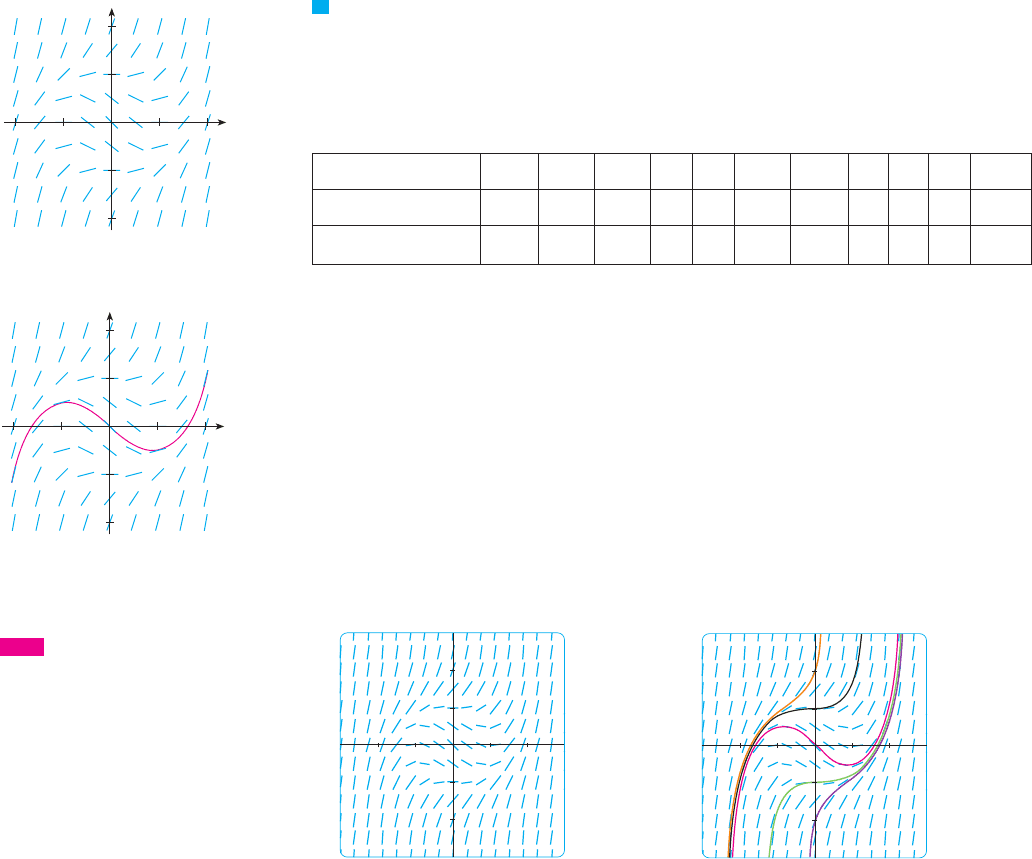
Now we can sketch the solution curve through the point by following the direc-
tion field as in Figure 4. Notice that we have drawn the curve so that it is parallel to near-
by line segments.
In general, suppose we have a first-order differential equation of the form
where is some expression in and . The differential equation says that the slope
of a solution curve at a point on the curve is . If we draw short line segments
with slope at several points , the result is called a direction field (or slope
field). These line segments indicate the direction in which a solution curve is heading, so
the direction field helps us visualize the general shape of these curves.
EXAMPLE 1
(a) Sketch the direction field for the differential equation .
(b) Use part (a) to sketch the solution curve that passes through the origin.
SOLUTION
(a) We start by computing the slope at several points in the following chart:
Now we draw short line segments with these slopes at these points. The result is the
direction field shown in Figure 5.
(b) We start at the origin and move to the right in the direction of the line segment
(which has slope ). We continue to draw the solution curve so that it moves parallel
to the nearby line segments. The resulting solution curve is shown in Figure 6. Returning
to the origin, we draw the solution curve to the left as well. M
The more line segments we draw in a direction field, the clearer the picture becomes.
Of course, it’s tedious to compute slopes and draw line segments for a huge number of
points by hand, but computers are well suited for this task. Figure 7 shows a more detailed,
computer-drawn direction field for the differential equation in Example 1. It enables us to
draw, with reasonable accuracy, the solution curves shown in Figure 8 with -intercepts
, , , , and .
F I G U R E 7
3
_3
_3 3
F I G U R E 8
3
_3
_3 3
210#1#2
y
#1
y" ! x
2
% y
2
# 1
V
!x, y"F!x, y"
F!x, y"!x, y"
yxF!x, y"
y" ! F!x, y"
!0, 1"
SECTION 10.2 DIRECTION FIELDS AND EULER’S METHOD
|| ||
609
x #2 #1 0 1 2 #2 #1 0 1 2 . . .
y 0 0 0 0 0 1 1 1 1 1 . . .
3 0 #1 0 3 4 1 0 1 4 . . .y" ! x
2
% y
2
# 1
0
x
y
1_1_2
1
2
-1
_2
F I G U R E 5
2
Module 10.2A shows direction
fields and solution curves for a variety of
differential equations.
TE C
0
x
y
1 2_1_2
1
2
-1
_2
F I G U R E 6

Now let’s see how direction fields give insight into physical situations. The simple elec-
tric circuit shown in Figure 9 contains an electromotive force (usually a battery or gener-
ator) that produces a voltage of volts (V) and a current of amperes (A) at time t.
The circuit also contains a resistor with a resistance of R ohms ( ) and an inductor with
an inductance of L henries (H).
Ohm’s Law gives the drop in voltage due to the resistor as RI. The voltage drop due to
the inductor is . One of Kirchhoff’s laws says that the sum of the voltage drops is
equal to the supplied voltage . Thus we have
which is a first-order differential equation that models the current at time .
EXAMPLE 2 Suppose that in the simple circuit of Figure 9 the resistance is , the
inductance is 4 H, and a battery gives a constant voltage of 60 V.
(a) Draw a direction field for Equation 1 with these values.
(b) What can you say about the limiting value of the current?
(c) Identify any equilibrium solutions.
(d) If the switch is closed when so the current starts with , use the direc-
tion field to sketch the solution curve.
SOLUTION
(a) If we put , , and in Equation 1, we get
The direction field for this differential equation is shown in Figure 10.
(b) It appears from the direction field that all solutions approach the value 5 A, that is,
(c) It appears that the constant function is an equilibrium solution. Indeed, we
can verify this directly from the differential equation . If , then
the left side is and the right side is .15 # 3!5" ! 0dI#dt ! 0
I!t" ! 5dI#dt ! 15 # 3I
I!t" ! 5
lim
t
l
*
I!t" ! 5
F I G U R E 1 0
0 t
1
I
2 3
2
4
6
dI
dt
! 15 # 3Ior4
dI
dt
% 12I ! 60
E!t" ! 60R ! 12L ! 4
I!0" ! 0t ! 0
12 +
V
tI
L
dI
dt
% RI ! E!t"
1
E!t"
L!dI#dt"
+
I!t"E!t"
610
|| ||
CHAPTER 10 DIFFERENTIAL EQUATIONS
R
E
switch
L
F I G U R E 9
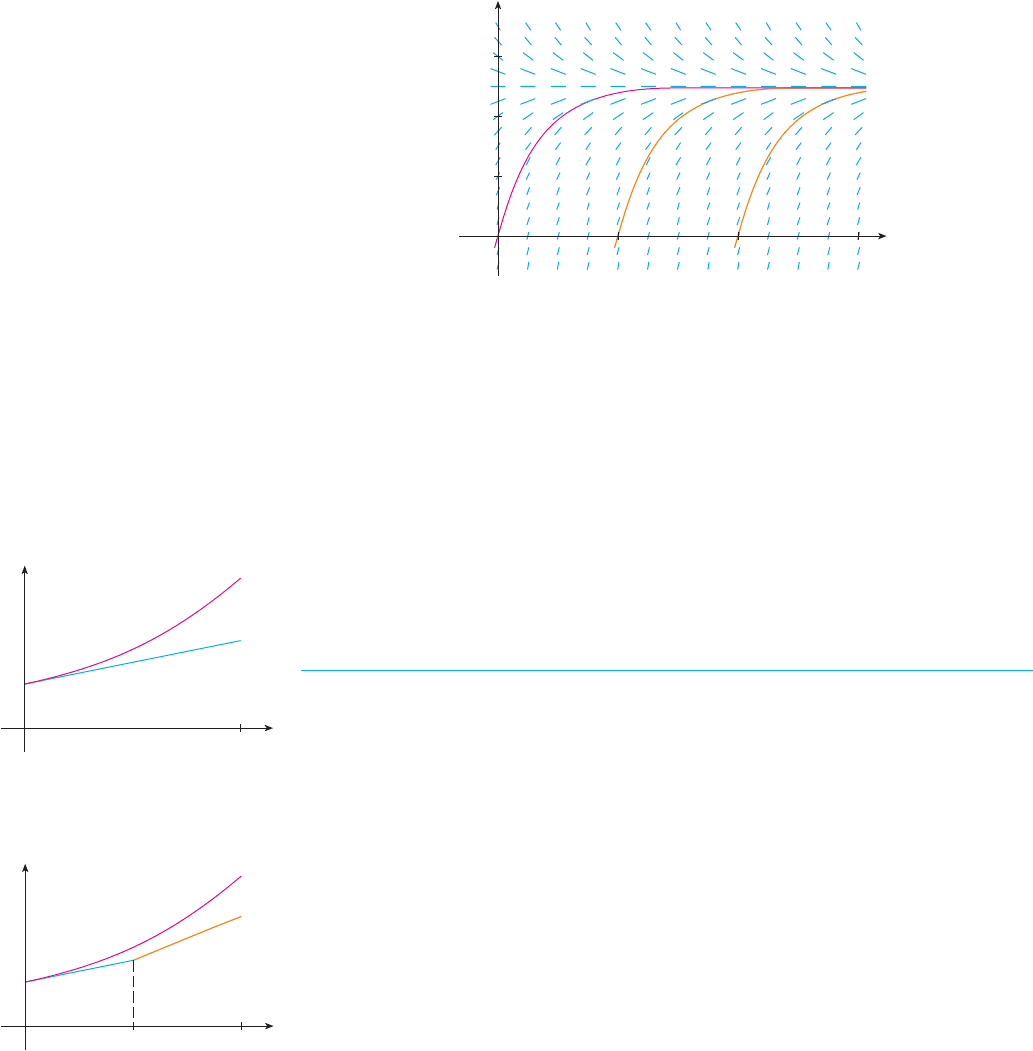
(d) We use the direction field to sketch the solution curve that passes through , as
shown in red in Figure 11.
M
Notice from Figure 10 that the line segments along any horizontal line are parallel. That
is because the independent variable t does not occur on the right side of the equation
. In general, a differential equation of the form
in which the independent variable is missing from the right side, is called autonomous.
For such an equation, the slopes corresponding to two different points with the same
y-coordinate must be equal. This means that if we know one solution to an autonomous
differential equation, then we can obtain infinitely many others just by shifting the graph
of the known solution to the right or left. In Figure 11 we have shown the solutions
that result from shifting the solution curve of Example 2 one and two time units (namely,
seconds) to the right. They correspond to closing the switch when or .
EULER’S METHOD
The basic idea behind direction fields can be used to find numerical approximations to
solutions of differential equations. We illustrate the method on the initial-value problem
that we used to introduce direction fields:
The differential equation tells us that , so the solution curve has slope
1 at the point . As a first approximation to the solution we could use the linear approx-
imation . In other words, we could use the tangent line at as a rough
approximation to the solution curve (see Figure 12).
Euler’s idea was to improve on this approximation by proceeding only a short distance
along this tangent line and then making a midcourse correction by changing direction as
indicated by the direction field. Figure 13 shows what happens if we start out along the
tangent line but stop when . (This horizontal distance traveled is called the step
size.) Since , we have and we take as the starting point
for a new line segment. The differential equation tells us that , so
we use the linear function
y ! 1.5 % 2!x # 0.5" ! 2x % 0.5
y"!0.5" ! 0.5 % 1.5 ! 2
!0.5, 1.5"y!0.5" $ 1.5L!0.5" ! 1.5
x ! 0.5
!0, 1"L!x" ! x % 1
!0, 1"
y"!0" ! 0 % 1 ! 1
y!0" ! 1y" ! x % y
t ! 2t ! 1
y" ! f !y
"
I" ! 15 # 3I
F I G U R E 1 1
0 t
1
I
2 3
2
4
6
!0, 0"
SECTION 10.2 DIRECTION FIELDS AND EULER’S METHOD
|| ||
611
y
x0
1
1
y=L(x)
solution curve
F I G U R E 1 2
First Euler approximation
y
x0
1
1
0.5
1.5
F I G U R E 1 3
Euler approximation with step size 0.5
